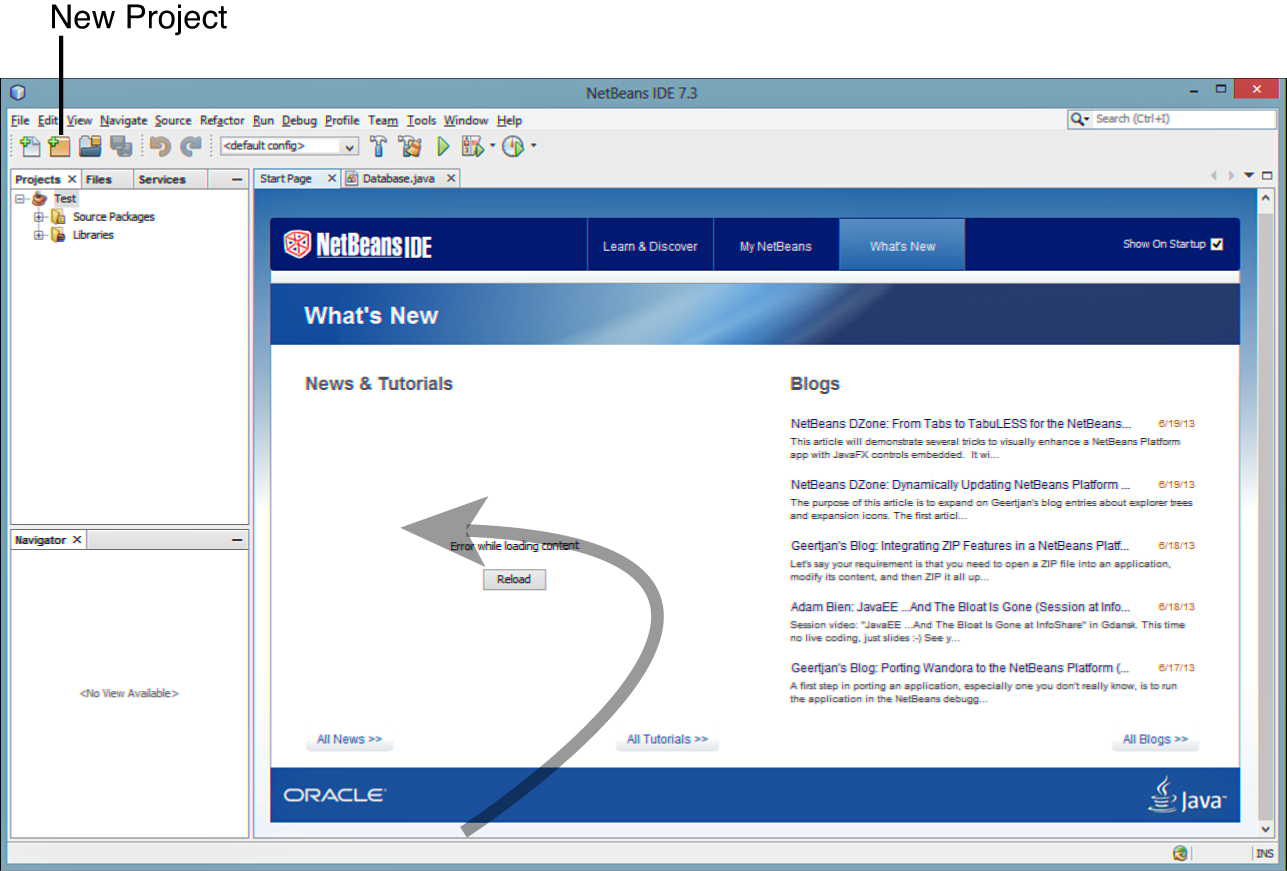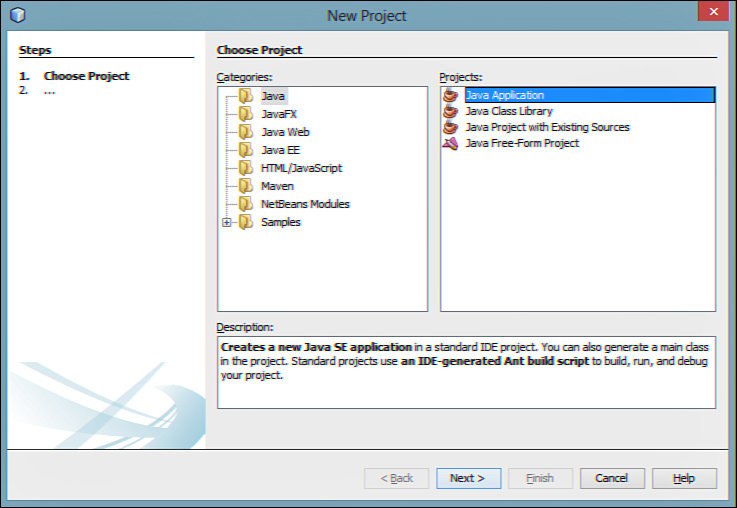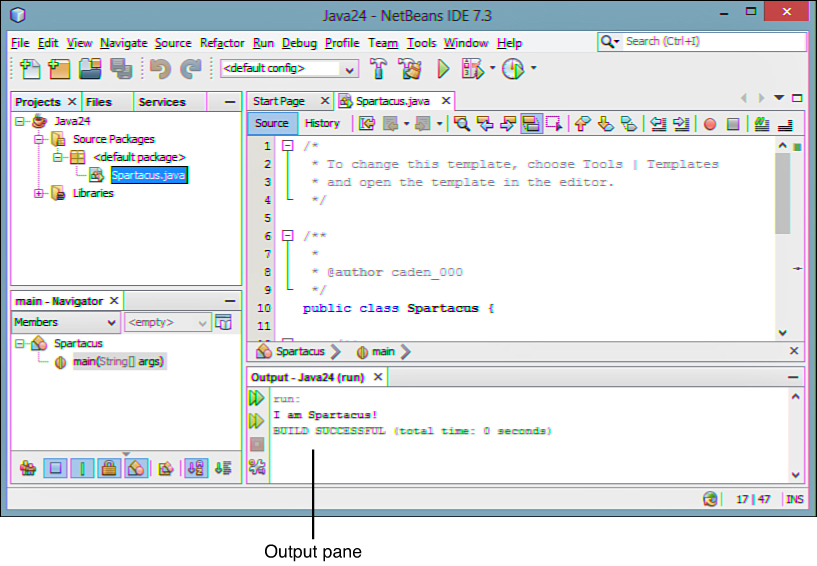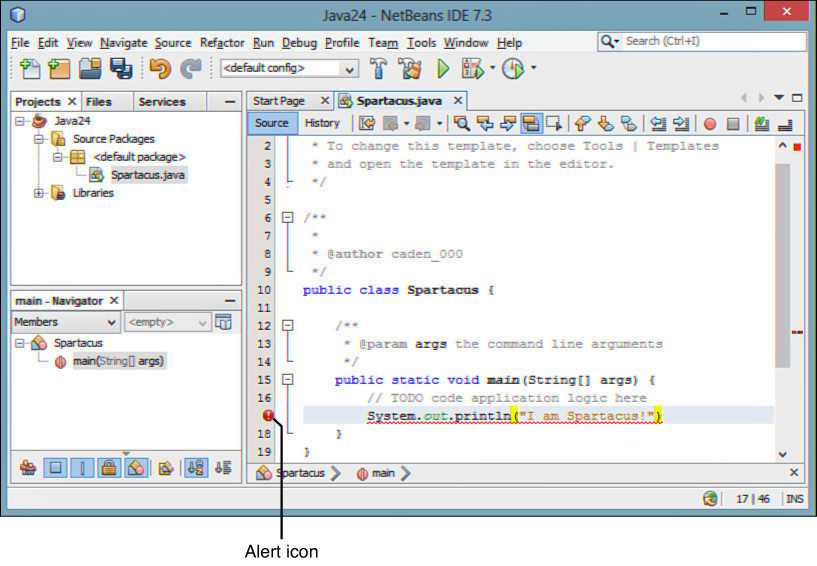Appendix B. Using the NetBeans Integrated Development Environment
Although it’s possible to create Java programs with nothing more than the Java Development Kit and a text editor, the experience is considerably more pleasant when you use an integrated development environment (IDE).
The four hours of this book devoted to Java programming employ NetBeans, a free IDE offered by Oracle for Java programmers. NetBeans is a program that makes it easier to organize, write, compile, and test Java software. It includes a project and file manager, graphical user interface designer, and many other tools. One killer feature is a code editor that automatically detects Java syntax errors as you type.
Now in version 7.3, NetBeans has become a favorite of professional Java developers, offering functionality and performance that would be worth the money at 10 times the price. It’s also one of the easiest IDEs for Java novices to use.
In this appendix, you learn enough about NetBeans to install the software and put it to use as you are introduced to Java programming.
Installing NetBeans
From inauspicious beginnings, the NetBeans IDE has grown to become one of the leading programming tools for Java developers. James Gosling, the creator of the Java language, gave it the ultimate vote of confidence in his foreword to the book NetBeans Field Guide: “I use NetBeans for all my Java development.” I’ve become a convert as well.
NetBeans supports all facets of Java programming for the three editions of the language—Java Standard Edition (JSE), Java Enterprise Edition (JEE), and Java Mobile Edition (JME). It also supports web application development, web services, and JavaBeans.
You can download the software, available for Windows, MacOS, and Linux, from www.netbeans.org. NetBeans is available for download bundled with the Java Development Kit, which is the option to choose if you don’t already have the kit on your computer.
Creating a New Project
The JDK and NetBeans are downloaded as installation wizards that set up the software on your system. You can install the software in any folder and menu group you like, but it’s best to stick with the default setup options unless you have a good reason to do otherwise.
When you run NetBeans for the first time after installation, you see a start page that displays links to news and programming tutorials (see Figure B.1). You can read these within the IDE using NetBeans’ built-in web browser.
A NetBeans project consists of a set of related Java classes, files used by those classes, and Java class libraries. Each project has its own folder, which you can explore and modify outside of NetBeans using text editors and other programming tools.
To begin a new project, click the New Project button shown in Figure B.1 or choose the File, New Project menu command. The New Project Wizard opens, as shown in Figure B.2.
NetBeans can create several different types of Java projects, but during this book you can focus on one type: Java Application.
For your first project (and most of the projects in this book), choose the project type Java Application and click Next. The wizard asks you to choose a name and location for the project.
The Project Location text field identifies the root folder of the programming projects you create with NetBeans. With Windows, this may be a subfolder of your My Documents (or Documents) folder named NetBeansProjects. All projects you create are stored inside this folder, each in its own subfolder.
In the Project Name text field, enter FirstProject. The Create Main Class text box changes in response to the input, recommending a name for the main Java class in the project. Change this to Spartacus and click Finish, accepting all other defaults. NetBeans creates the project and its first class.
Creating a New Java Class
When NetBeans creates a new project, it sets up all the necessary files and folders and creates the main class. Figure B.3 shows the first class in your project, Spartacus.java, open in the source editor.
Spartacus.java is a bare-bones Java class that consists only of a main() method. All the light gray lines in the class are comments that explain the purpose and function of the class. Comments are ignored when the class is run.
To make the new class do something, add the following line of code on a new line right below the comment // TODO code application logic here:
System.out.println("I am Spartacus!");
The method System.out.println() displays a string of text, in this case the sentence “I am Spartacus!”
Make sure to enter this exactly as it appears. As you type, the source editor figures out what you’re doing and pops up helpful information related to the System class, the out instance variable, and the println() method. You’ll love this helpfulness later, but for now, try your best to ignore it.
After you make sure you typed the line correctly and ended it with a semicolon, click the Save All Files toolbar button to save the class.
Java classes must be compiled into executable bytecode before you can run them. NetBeans tries to compile classes automatically. You also can manually compile this class in two ways:
![]() Choose the menu command Run, Compile File.
Choose the menu command Run, Compile File.
![]() Right-click
Right-click Spartacus.java in the Projects pane to open a pop-up menu and choose Compile File.
If NetBeans doesn’t allow you to choose either of these options, that means it already has compiled the class automatically.
If the class does not compile successfully, a red exclamation point appears next to the filename Spartacus.java in the Projects pane. To fix the error, compare what you’ve typed in the text editor to the full source code of Spartacus.java in Listing B.1 and save the file again.
LISTING B.1 The Java class Spartacus.java
/*
* To change this template, choose Tools | Templates
* and open the template in the editor.
*/
/**
*
* @author Greg Perry
*/
public class Spartacus {
/**
* @param args the command line arguments
*/
public static void main(String[] args) {
// TODO code application logic here
System.out.println("I am Spartacus!");
}
}
The class is defined beginning with the line public class Spartacus { and ending with the } on the last line. The lines above that are comments included by NetBeans in every new class when you choose Java Application as the project type.
Running the Application
After you’ve created the Java class Spartacus.java and compiled it successfully, you can run it within NetBeans in two ways:
![]() Choose Run, Run File from the menu.
Choose Run, Run File from the menu.
![]() Right-click
Right-click Spartacus.java in the Projects pane and choose Run File.
When you run a Java class, its main() method is called by the compiler. The string “I am Spartacus!” appears in the Output pane, as shown in Figure B.4.
A Java class must have a main() method to be run. If you attempt to run a class that lacks one, NetBeans responds with an error.
After you’re done reviewing the program’s output, close the Output pane by clicking the X on the pane’s tab. This makes the source editor larger, which comes in handy when you are creating a program.
Fixing Errors
Now that the Spartacus application has been written, compiled, and run, it’s time to break something to get some experience with how NetBeans responds when things go terribly wrong.
Like any programmer, you’ll have plenty of practice screwing things up on your own, but pay attention here anyway.
Return to Spartacus.java in the source editor and take the semicolon off the end of the line that calls System.out.println() (line 17 in Listing B.1). Even before you save the file, NetBeans spots the error and displays a red alert icon to the left of the line (see Figure B.5).
Hover over the alert icon to see a dialog appear that describes the error NetBeans thinks it has spotted.
The NetBeans source editor can identify most of the common programming errors and typos that it encounters as you write a Java program. The detection of an error stops the file from being compiled until the error has been fixed.
Put the semicolon back at the end of the line. The alert icon disappears and you can save and run the class again.
These basic features are all you need to create and compile the Java programs in this book.
NetBeans is capable of a lot more than the basic features described here, but you should focus on learning Java before diving too deeply into the IDE. Use NetBeans as if it was just a simple programming project manager and text editor. Write classes, flag errors, and make sure you can compile and run each project successfully.
When you’re ready to learn more about NetBeans, the Start page that displays every time the program is run offers resources to learn how to use it. Oracle also offers training and documentation resources at www.netbeans.org/kb.





